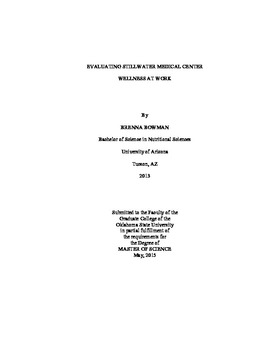| dc.contributor.advisor | Gates, Gail E. | |
| dc.contributor.author | Bowman, Brenna | |
| dc.date.accessioned | 2016-04-15T21:49:11Z | |
| dc.date.available | 2016-04-15T21:49:11Z | |
| dc.date.issued | 2015-05-01 | |
| dc.identifier.uri | https://hdl.handle.net/11244/33393 | |
| dc.description.abstract | Objective: The purpose of this study was to evaluate dietary behaviors of Stillwater Medical Center (SMC) employees and their perceptions of SMC Wellness at Work before and after implementation of the program. Design: A pre-survey was administered to employees through SurveyMonkey in February and a post-survey was administered in August with questions about diet behaviors, attitudes and participation in the interventions. Setting: Interventions took place in the SMC cafeteria and snack bar. Participants: Two hundred and seventy-seven employees completed the pre-survey and 164 employees responded to the post-survey. Interventions: Four interventions followed pre-survey administration: reducing sugar-sweetened beverage intake through Rethink Your Drink signage, providing nutrition facts labels on cafeteria and snack bar items, offering healthier cafeteria options through Try It Tuesdays once per month, and offering nutrition education through videos on the employee blog. Main Outcome Measures: Mean diet scores and frequency of Try It Tuesday participation. Analysis: T-tests were used to compare pre- and post-diet scores. Confidence intervals were used to evaluate influences on Try It Tuesday purchases. ANOVA was used to compare diet scores and Try It Tuesday participation by department. Results: Diet scores and attitudes did not change significantly after six months of intervention. Among departments, Imaging had the highest pre-intervention diet score (15.4 � 2.8) and Patient Access Services had the highest score post-intervention (15.0 � 1.7). Personal taste preference had the greatest influence on Try It Tuesday purchases. Conclusions and Implications: Diet scores and attitudes did not significantly change over time, possibly because the interventions were not sufficiently long or intense enough to produce an effect. Future research requires policy and more extensive environment changes in the workplace. Practitioners should implement multi-component employee wellness programs for greatest success. | |
| dc.format | application/pdf | |
| dc.language | en_US | |
| dc.publisher | Oklahoma State University | |
| dc.rights | Copyright is held by the author who has granted the Oklahoma State University Library the non-exclusive right to share this material in its institutional repository. Contact Digital Library Services at lib-dls@okstate.edu or 405-744-9161 for the permission policy on the use, reproduction or distribution of this material. | |
| dc.title | Evaluating Stillwater Medical Center Wellness at Work | |
| dc.type | text | |
| dc.contributor.committeeMember | Soliah, Lu Ann | |
| dc.contributor.committeeMember | Hermann, Janice | |
| osu.filename | Bowman_okstate_0664M_13737.pdf | |
| osu.accesstype | Open Access | |
| dc.description.department | Nutritional Science | |
| dc.type.genre | Thesis | |
